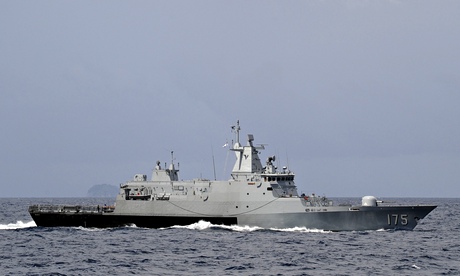
Royal Malaysian Navy's
offshore patrol vessel KD Kelantan leaves for southern corridor during a
search and rescue operation for the missing Malaysia Airlines plane.
Photograph: AP
The full scale of the vast hunt for the missing Malaysia Airlines flight became clear on Tuesday, as officials said the search area had been extended to 2.24m square nautical miles (7.68m sq km).
Malaysian officials urged countries on the plane's potential path to reanalyse their military radar data in the hope of narrowing down the area – roughly the size of Australia – which comprises two great arcs sweeping north towards Kazakhstan and deep into the southern Indian Ocean far off the coast of Australia.
A coalition of 26 countries is looking for Flight MH370, which vanished on 8 March with 239 people aboard en route from Kuala Lumpur to Beijing. China said it had deployed 21 of its satellites.
The expansion of the 10-day search came as it was reported the plane was seemingly first diverted from its scheduled course through instructions entered into a flight computer rather than from manual controls, increasing the likelihood it was a deliberate act by someone with extensive knowledge of the aircraft.
Quoting unnamed US officials, the New York Times said the turn away from Beijing appeared to have been entered into the flight management system, which sits between the pilot and co-pilot. It was not clear if the instruction was entered before takeoff or in flight.
Several countries, including Laos and Kazakhstan, have already said they have found no evidence that MH370 entered their airspace after diverting from its route to Beijing.
"This is an enormous search area. And it is something that Malaysia cannot possibly search on its own," said the transport minister, Hishammuddin Hussein.
"All efforts are being used now to reduce the [search] area – looking at satellite data; seeking assistance from other friends who have satellite capability; asking if they have looked [at radar data] to relook at them; finally, the use of assets whether in air or at sea."
Hishammuddin said China and Kazakhstan were taking the lead in the search of the northern arc, while Indonesia and Australia were taking charge in the south.
John Young, emergency response general manager of the Australian Maritime Safety Authority, said it was focusing on an area 3,000km (1,850 miles) south-west of Perth.
"This search will be difficult … a needle in a haystack remains a good analogy," he told the Australian Associated Press, adding that planes were looking for wreckage or other debris on the surface only and were not equipped to search underwater.
"It will take at least a few weeks to search the area thoroughly," Young added.
The aerial search will use infrared technology to scan the ocean surface, Australian Defence Force Group Captain Stuart Bellingham said. "We are not looking underwater at all and we don't have the capability to pick up black boxes or underwater electronic beacons."
There is little radar coverage over the southern Indian Ocean, making it harder to narrow down the search there. The average depth of the ocean is more than two miles.
Earlier, the Chinese ambassador to Malaysia said the country had begun searching its own territory for any sign of the plane. Huang Huikang also said that extensive checks on all Chinese passengers on board MH370 found no evidence they were involved in the diversion of the plane. Malaysian officials have said they believe the plane was diverted deliberately, but say they are not ruling out any possible reasons for the diversion. It is not clear who was flying the plane at the time, although on Monday authorities said the last verbal communication was with the co-pilot, two minutes before the transponder was switched off at 1.21am, ensuring the plane could not be tracked by the civil radar system.
A multinational team of investigators has established that the plane's last contact with satellites was at 8.11am, but so far cannot place its location at that time any more specifically than along the immense search arcs. More than 150 Chinese nationals were among the 239 people on the Beijing-bound flight when it disappeared. Investigators say they are looking into the background of all crew, ground staff and passengers.
China "conducted meticulous investigation into all the [Chinese] passengers, and did not find any evidence for sabotage activity", Huang told a press briefing, the South China Morning Post reported.
State news agency Xinhua reported that the country's premier, Li Keqiang, rang the Malaysian prime minister, Najib Razak, on Monday, asking him to provide Beijing with more detailed data and information in a timely, accurate and comprehensive manner.
He added that despite the difficulty of the search, "as long as there is still a gleam of hope, we should continue to do our utmost".
While China has urged Malaysia to be more transparent, its foreign ministry spokesman, Hong Lei, declined to give any details of its own search – such as when it began to search its own territory, which agencies were involved and what regions were covered.
The ambassador to Malaysia also said that because a criminal investigation was under way, "the probe into the incident's cause is not suitable to be conducted in a high-profile way".

No comments:
Post a Comment